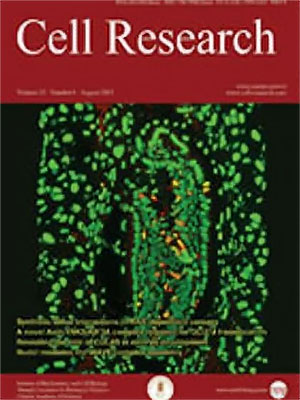
Volume 15, No 2, Feb 2005
ISSN: 1001-0602
EISSN: 1748-7838 2018
impact factor 17.848*
(Clarivate Analytics, 2019)
Volume 15 Issue 2, February 2005: 133-140
ORIGINAL ARTICLES
Characterization of a novel developmentally retarded mutant (drm1) associated with the autonomous flowering pathway in Arabidopsis
Yong ZHU1,2,*, Hui Fang ZHAO1,3,*, Guo Dong REN1, Xiao Fei YU1, Shu Qing CAO1, Ben Ke KUAI1,4,**
1Department of Biochemistry, Ministry of Education Key laboratory for Biodiversity Science and Ecological Engineering, School of Life Sciences, Fudan University, 220 Handan Road, Shanghai 200433, China;
2School of Horticulture and Gardening, Southwest Forestry College, Kun Ming 650224, China;
3Department of biology, School of Life and Environment Science, Shanghai Normal University, Shanghai 200234, China
4Fudan Centre for Genetic Diversity and designed Agriculture, Fudan University, 220 Handan Road, Shanghai 200433, China
Correspondence: Ben Ke Kuai(bkkuai@fudan.edu.cn)
A developmentally retarded mutant (drm1) was identified from ethyl methanesulfonate (EMS)-mutagenized M2 seeds in Columbia (Col-0) genetic background. The drm1 flowers 109 d after sowing, with a whole life cycle of about 160 d. It also shows a pleiotropic phenotype, e.g., slow germination and lower germination rate, lower growth rate, curling leaves and abnormal floral organs. The drm1 mutation was a single recessive nuclear mutation, which was mapped to the bottom of chromosome 5 and located within a region of 20-30 kb around MXK3.1. There have been no mutants with similar phenotypes reported in the literature, suggesting that DRM1 is a novel flowering promoting locus. The findings that the drm1 flowered lately under all photoperiod conditions and its late flowering phenotype was significantly restored by vernalization treatment suggest that the drm1 is a typical late flowering mutant and most likely associated with the autonomous flowering pathway. The conclusion was further confirmed by the revelation that the transcript level of FLC was constantly upregulated in the drm1 at all the developmental phases examined, except for a very early stage. Moreover, the transcript levels of two other important repressors, EMF and TFL1, were also upregulated in the drm1, implying that the two repressors, along with FLC, seems to act in parallel pathways in the drm1 to regulate flowering as well as other aspects of floral development in a negatively additive way. This helps to explain why the drm1 exhibits a much more severe late-flowering phenotype than most late-flowering mutants reported. It also implies that the DRM1 might act upstream of these repressors.
FULL TEXT | PDF
Browse 1935


